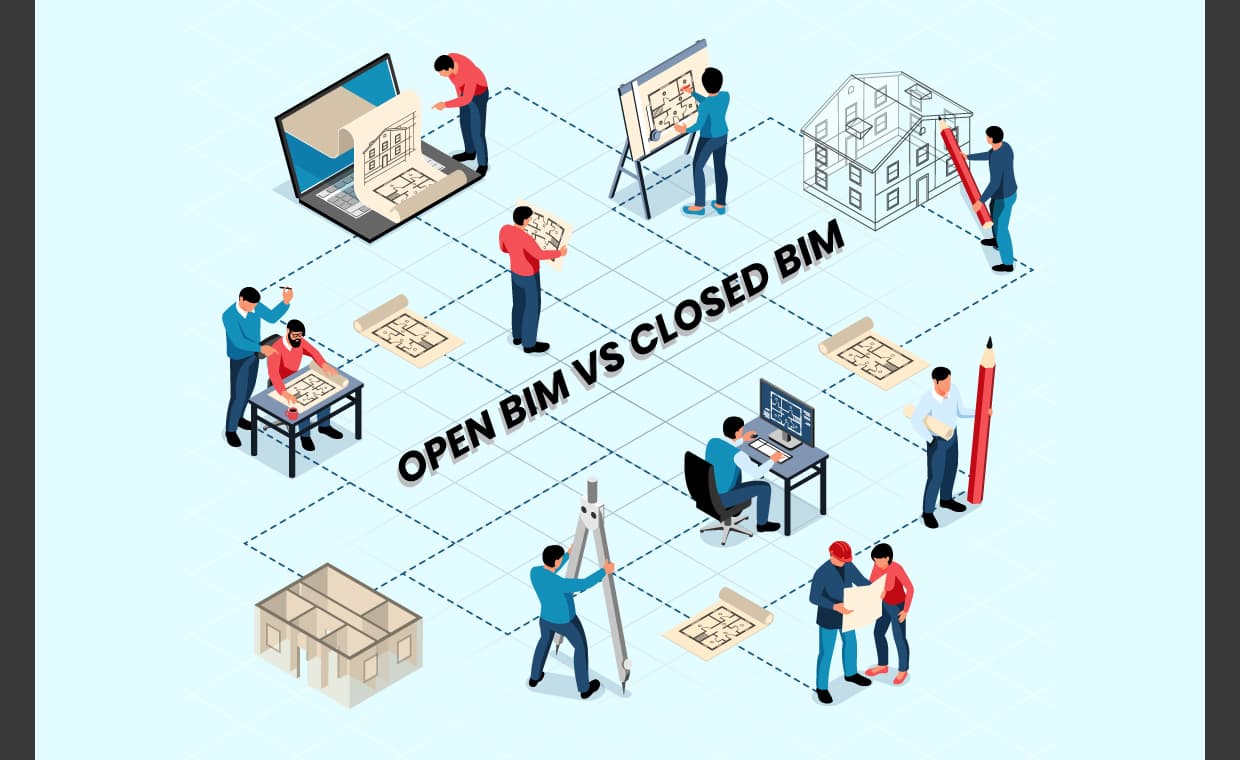
Building Information Modelling, or BIM, is a new-age tool widely used in the AEC (Architecture, Engineering, and Construction) industry to model and design buildings of varied scales. Initially, BIM was associated only with large-scale, complex projects. However, over time, BIM is being used for residential projects as well, and this is significant progress in the AEC industry. In the following blog, Gharpedia shares information on both BIM systems and open BIM vs. closed BIM.
Advancements in BIM technology are leading to pivotal developments, and even relatively smaller firms are making use of this right from the strategic level of planning. The selection of the right BIM tool and its implementation determine the project’s success. Thus, BIM is the culmination of three main aspects of planning: process, product, and practice. The right strategy coupled with the right set of tools can help BIM solve complications in construction and help manage multiple stakeholders in a project easily.
Find out more here Building Information Modelling: 16 Benefits of BIM You Must Know
The Growth of BIM in AEC Industry: BIM as a Tool for Collaboration

BIM has evolved not only as a tool for design management but has also proven to be a great resource for design collaboration and communication. An architectural project involves varied stakeholders, such as architects, contractors, MEP engineers, Structural consultants, etc. BIM has developed a system wherein these stakeholders can monitor and communicate design through their tools in real time. This evolution in architectural design and project execution showcases the revolution that BIM has brought.
However, while various stakeholders use different tools, there are many ways of executing BIM systems, which can lead to clashes. Thus, to establish a common ground and help all the stakeholders collaborate on a project, there exists the concept of Open BIM and Closed BIM.
Let us understand what these BIM systems are and look at their advantages and disadvantages.
Open BIM
Open BIM workflows help different project stakeholders collaborate and access project information through a non-proprietary, neutral file format. This is unaffected by the variations in BIM applications used by different entities in a project. This system includes the BIM model’s geometric data and parametric information like material specifications, costs involved, stages of building construction, procurement of materials, and much more. Open BIM is therefore a more progressive approach to construction, as it leads to improved coordination among the designers and other stakeholders. AEC projects are complex when it comes to handling information.
For instance, the execution of a residential project entails the exchange of a lot of drawings and material information between the architect, the contractor, and the civil engineer. Open BIM software allows each of them to have a common ground and access to data using a standardised process and a universal common language between them. This is irrespective of the fact that the architect might be using ArchiCAD, while the contractor might use Sketchup and the civil engineer might use Civil 3D; it simply does not matter. Open BIM accommodates everyone and retains the data quality, thereby preventing multiple inputs of identical data. Thus, open BIM is more streamlined and user-friendly.
Closed BIM
Closed BIM is also called ‘lonely BIM’. It is an environment where multiple stakeholders involved in a project can use the same BIM application, and this requirement of the same system is also at times in terms of the versions of the software used.
Different stakeholders make use of applications depending on the scope of their work on the projects, and this necessarily does not have to be software from the same vendors with the same versions. But Closed BIM has no provision for this variation. It requires stakeholders to use applications from the same vendor. For instance, in a residential project developed under the Closed BIM system, if the designer uses Revit Architecture to model architectural elements, the structural engineer will have to use Revit Structure, whereas the MEP consultant will have to use Revit MEP. Though closed BIM does not involve any need for file conversions, the restriction on the same software vendor is a major shortcoming.
Why? First, it requires different stakeholders to be trained in the same software suite. Secondly, it can be challenging if the collaborators on a project are from different geographical locations using different software.
But Closed BIM is preferred, as, in a way, it lowers the technical problems caused at times due to the involvement of multiple software systems.
Verdict: Who Wins? Open BIM vs Closed BIM

So which system is better? Open BIM or Closed BIM?
Surely Open BIM proves to be more resourceful. Unlike Closed BIM, Open BIM is transparent and accessible. It sets up a more collaborative and open workflow. This allows the project members to work seamlessly, irrespective of the software. It ensures easy access to project information throughout the project life cycle. Thus, enabling the involvement of different software vendors in a project. In a closed BIM, data is recorded in a non-neutral format that can be accessed only by a single system. This further reduces versatility and makes extracting models from different software or versions of software impossible, thus making the process less user-friendly.
This restrictive nature of Closed BIM further raises the issues of the authenticity and accuracy of the data stored. On the other hand, in an Open BIM system, files can easily be exported and exchanged between multiple entities, and since there is no limitation on the platform, there is also no loss of data or doubts about accuracy.
Open BIM & its Bright Future

Open BIM will drive the future of architecture, design, and construction, due to its features such as:
Resourcefulness
Open BIM format is resourceful when it comes to transferring data- import or export and ensuring the quality of the data throughout.
It proves reliable for projects involving variations in design techniques, geographical locations, and time zones.
Improved Teamwork
Open BIM standards empower users to directly access products and information. This helps them to download data and add data in the format and interface they are comfortable working with. This makes use of a common IFC (International Foundation Class) file format that is accessible to all. Thus, enhancing and boosting team collaboration.
Clarity
An open BIM integrates real-time data, making it easy for all the stakeholders to track the progress of the project. This also enables the on-site teams to add last-minute site-specific changes in the design onto a common system, reflecting them in real-time at the interface of the off-site teams, making designs transparent and clear for all.
For e.g.: A US-based company wants to build residential quarters for its Indian employees in India. An open BIM system will help contractors in India to have the design information given by the designers in the US and vice versa, and there will be real-time access to data irrespective of the time difference and difference in design tools.
In Conclusion
Collaboration is making pivotal changes in the AEC industry, and BIM is driving this change. Even residential projects make use of technological innovations like AR, VR, and AI for planning, visualisation, and project communication. In this age of technological transformations, the simplistic and open-ended workflow of Open BIM systems will surely help in turning visions into reality. Advanced systems will require advanced tools and professionals to brainstorm together. Thus, open BIM can emerge as a promising future to align processes better and make construction management seamless. Therefore, Open BIM is the ultimate solution to the obstacles. It can solve the shortcomings faced in construction owing to systems that restrict workflows due to tools and software suites.






























